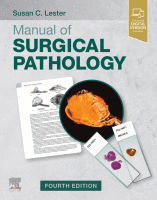Physical Address
304 North Cardinal St.
Dorchester Center, MA 02124

Thyroid Resection Thyroid surgery is usually performed to remove solitary nodules (benign or malignant), multinodular goiters, or, rarely, for the treatment of Graves’ disease. Thyroid resection specimens include total thyroidectomies, near-total thyroidectomies, hemithyroidectomies, lobectomies, and isthmusectomies. Many nodules will have…

The thymus may be removed due to disease (both benign and malignant tumors), for the treatment of myasthenia gravis, or, rarely, incidentally during thoracic surgery (e.g., open heart surgery). If the specimen is of an anterior mediastinal mass, one must…

Soft tissue tumors are among the most difficult neoplasms to diagnose. Often special studies (e.g., immunoperoxidase studies, fluorescence in situ hybridization [FISH], or cytogenetics) are required for the appropriate classification of these tumors and for reliable separation from carcinomas, melanomas,…

. . The majority of penile carcinomas are squamous cell carcinomas arising in the glans (~50%), foreskin/prepuce (~20%; mucosal surface more commonly involved than outer surface), coronal sulcus (~5%), or, rarely, in other sites ( Fig. 27.1 ). About one-third…

## ## The adrenal medullary paraganglioma, pheochromocytoma, is discussed in Chapter 8 . The extra-adrenal paragangliomas are classified according to their location and site of origin, which corresponds to the paravertebral sympathetic chain: Abdominal extra-adrenal paragangliomas Organ of Zuckerkandl Urinary…

## ## Neuropathology cases include all brain and spinal cord specimens, pituitary glands, muscle and nerve biopsies, and eyes. RELEVANT CLINICAL HISTORY In addition to age and gender, clinical history is often necessary or helpful for the evaluation of neuropathology…

All foreign material removed from within human tissue is generally sent for pathologic evaluation and documentation. These can include objects introduced due to trauma (e.g., bullets or shrapnel) or for medical treatment (e.g., implanted ventricular assist devices). Medical devices temporarily…

## ## These organs are affected by a wide variety of neoplastic, infectious, and systemic diseases. These diseases can also arise in extranodal sites. RELEVANT CLINICAL HISTORY In addition to age and gender, clinical history is often necessary or helpful…

## Non-neoplastic diseases of the lung are usually diagnosed by bronchoalveolar lavage, transbronchial biopsies, and open lung biopsies. In institutions with lung transplant programs, chronically diseased recipient lungs (explants) are also submitted for examination and these patients are monitored by…

Hernia sacs are common surgical specimens derived from the frequent repair of inguinal, femoral, abdominal, and umbilical hernias. The sacs usually consist of a small portion of fibroconnective tissue lined by mesothelial tissue. A hernia sac is essentially a biopsy…